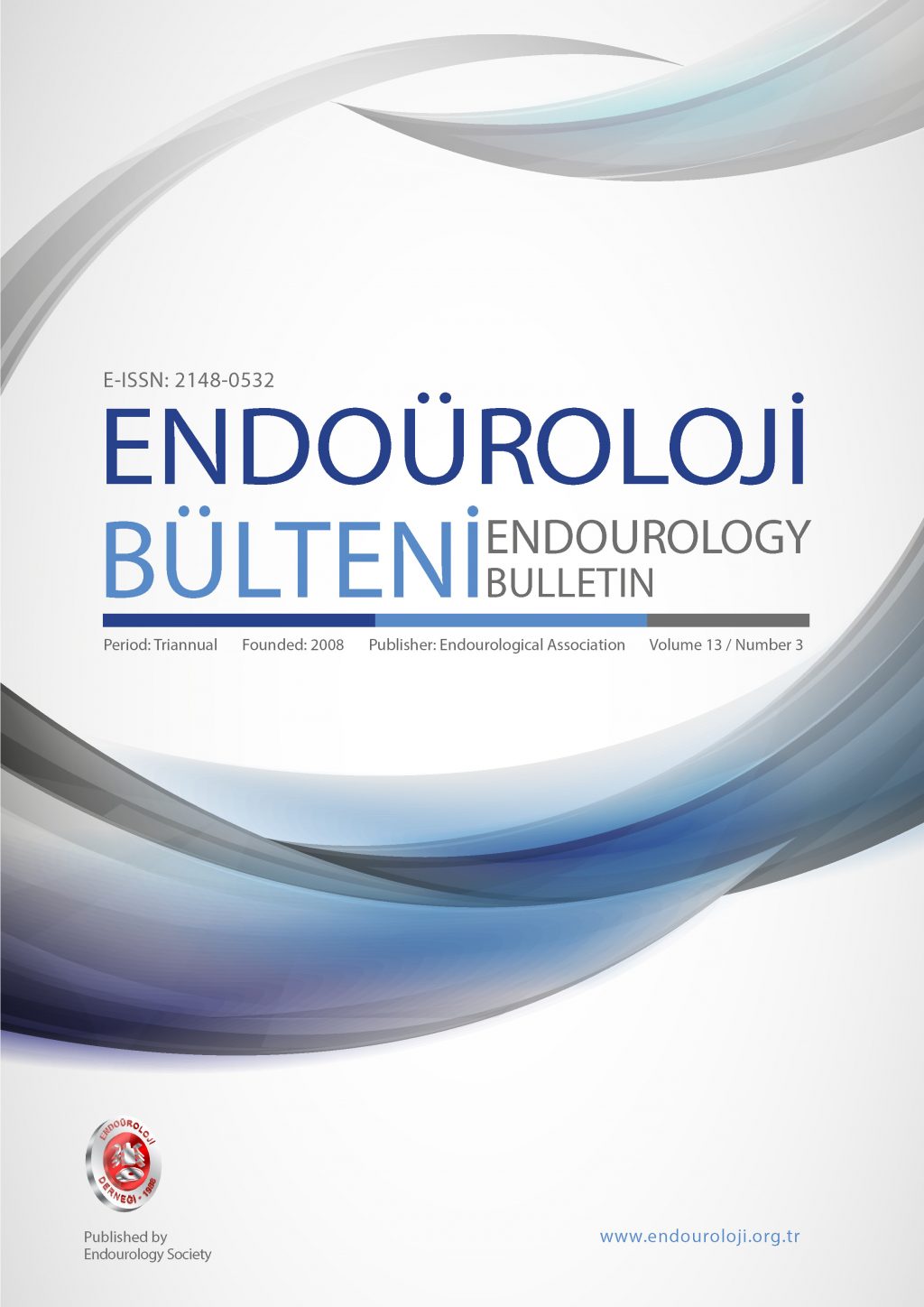
Editorial Board Message
Prof.Dr. R. Gökhan ATIŞ
Editorial Borad
Arbitrators List
Contents
Original Article
Clinical significance of radiographic and lithotripter parameters in predicting
ESWL success for kidney and ureteral stones
Özgur Efiloğlu , M.Çağlar Çakıcı , Hüseyin Özgür Kazan , Ferhat Keser , Asıf Yıldırım, Ramazan Gökhan Atış
Abstract
Objective: Extracorporeal shock wave lithotripsy (ESWL) is the most commonly utilized method for treating renal and proximal ureteral stones. We aimed to observe which parameters are efficacious for ESWL success.
Material and Methods: Between January 2017 and December 2018, 253 patients who underwent ESWL were analyzed retrospectively from our prospectively obtained ESWL database. 44 patients underwent ESWL due to ureteral stones and 209 patients due to kidney stones. Stone type, stone sizes, Hounsfield unit density (HUD), stone-skin distance (SSD) and location of stones, gender, and ages of patients, power, and number of shock waves and total sessions were analyzed.
Results: The overall treatment success rate was 71.1% for all stones, 70.3% for renal stones, and 75% for ureteral stones. Stone size, number of shock waves, and HUD were efficacious parameters to predict success for renal stones. In univariate analyses, age and stone size were predictors of success for ureteral stones. In multivariate analyses, just stone sizes were the only predictor of success for renal and ureteral stones (p=0.002 and p=0.005, respectively). The success rate can be predicted for ureteral stones with a sensitivity of 81.8% and specificity of 78% when 11.5 mm size is defined as a cut-off point.
Conclusion: Renal stones and proximal ureteral stones can be treated successfully with ESWL. Renal stones that are smaller and lower HUD have more success rates. When we talk about ureteral stones, younger patients and smaller stones can be fragmentized more effectively. The most important parameter for ESWL success is stone size.
Keywords: extracorporeal shock wave lithotripsy, renal stone, ureteral stone, hounsfield unit density
Original Article
Impact of statin use on perioperative bleeding in patients with benign prostatic hyperplasia who underwent monopolar TURP
Erkan Ölçücüoğlu, Emre Uzun, Sedat Taştemur, Yusuf Kasap, Samet Şenel
Abstract
Objective: We aimed to evaluate the effect of statin use on bleeding complications in benign prostate hyperplasia (BPH) patients who underwent transurethral resection of the prostate (TURP).
Material and Methods: This prospective case-control study included patients with benign prostatic hyperplasia (BPH) who underwent TURP surgery. Seventy-six patients were included (30 statin users and 74 statin non-users). Data including patient age, preoperative laboratory values(complete blood count, prostate-specific antigen (PSA) levels, prostate volume, international normalized ratio (INR), activated partial thromboplastin time (aPTT)), intraoperative characteristics(amount of resected prostate tissue, blood transfusion, duration of surgery, duration of urinary catheterization) and postoperative features(serum complete blood count, and length of hospital stay)were collected. Patients who underwent TURP with or without statin use were compared with hematocrit and bleeding complications.
Results: There was no difference between the groups regarding the degree of reduction in hematocrit and platelet count. In both groups, postoperative hematocrit and platelet counts were significantly lower than preoperative values. There was no significant difference between the groups regarding age, PSA, prostate volume, histopathological diagnosis, transurethral resection (TUR) volume, INR, PT, aPTT, number of red blood cell (RBC) units transfused, duration of surgery, irrigation time, hematocrit, and platelet count. TUR volume, frequency of anticoagulant use, duration, and length of hospital stay were statistically higher in the statin user group.
Conclusion: Our results showed that statin use did not impact bleeding in patients with BPH who underwent TURP. Considering the widespread use of statins, during surgery the effects of bleeding, we need more information on further studies to light.
Keywords: benign prostatic hyperplasia, bleeding, statin, transurethral resection of the prostate
Original Article
Effects of Fentanyl and Remifentanil on intraoperative hemodynamics and postoperative recovery in percutaneous nephrolithotomy cases
Yasemen Höbek Aydın, Dilek Öztürk Kazancı
Abstract
Objective: To compare the effects of fentanyl or remifentanil on intraoperative hemodynamic effects and postoperative recovery in patients undergoing percutaneous nephrolithotomy (PCNL).
Material and Methods: Randomized, and prospective study was conducted. Forty patients who underwent PCNL with American Society of Anaesthesiologist (ASA) I-II enrolled into the study. All patients were divided into 2 groups according to administered anaesthesiology technique and drugs, which are remifentanil and fentanyl. Induction of anaesthesia was same in both groups. Induction of anesthesia was obtained with a bolus dose of propofol (1-2 mg/kg), maintenance was achieved with sevoflurane (MAC2). Muscle relaxation was achieved with rocuronium. Group 1 was consisted of patients who were administered remifentanil and they received 1 μgr/kg of remifentanil as a single dose during the induction of anaesthesia Group 2 was received fentanyl 2 μg/kg as a single dose during the induction of anaesthesia. Group 1 received remifentanil 0.05 μgr/kg per minute as an infusion throughout the procedure for providing intraoperative hemodynamic stability, in group 2 fentanyl was given at a dose of 0.5 μg/kg iv bolus every 45 minutes. Intraoperative hemodynamic parameters and recovery data were recorded. Aldrete score, Ramsay sedation scale 15, 60, 360 minutes were noted after surgery. Visual analogue scale (VAS0-10)was used for pain evaluation.
Results: Intraoperative hemodynamic measurements were more stable in Group 1. The need for nitro-glycerine was significantly increased in Group 2 (p<0.05). The Aldrete scores, Ramsay sedation scales and VAS did not differ significantly between the groups. Immediate recovery was significiantly earlier in Group 1 than Group 2 (p<0.05).
Conclusion: Stable hemodynamic status and safer recovery can be provided with remifentanil compared to fentanyl during PCNL.
Keywords: fentanyl, percutaneous nephrolithotomy, remifentanil, visual analog score
Original Article
Management of renal colic in pregnant patients: a single-center experience
Şaban Oğuz Demirdöğen, Ahmet Emre Cinislioğlu, Bakytbek Kozubaev Usenbekovich, Salih Al
Abstract
Objective: We aimed to contribute to the literature by sharing the clinical features, conservative and surgical treatment results of pregnant patients who applied for renal colic.
Material and Methods: The patients’ demographic and clinical characteristics were evaluated; gestational week, history of calculus, laboratory and radiological examinations, details of the treatments applied to the patients, treatment practices of the patients to whom surgical treatment was applied, complications, characteristics of the patients during the follow-up period until delivery retrospectively.
Results: Twenty-one pregnant patients, who were followed up and treated at the department and applied with renal colic, were included in the study. The mean age of the patients was 27.2 ± 5.75 years. The average gestational week was 20.1±7.12. Of the patients, 14.3% were in the first trimester, 52.4% in the second trimester, and 33.3% in the third trimester. Fourteen patients (66.7%) applied with right renal colic and 7 (33.3%) with left renal colic. The mean visual analog scale (VAS) score at the time of application of the patients was 8.38 ± 0.86. The diagnosis was made via the ultrasonography (US) in 20 patients (95.2%). Magnetic resonance imaging (MRI) was only used in 1 (4.8%) patient. Conservative treatment was applied to 13 patients (61.9%) and surgical treatment to 8 patients (38.1%). Only a DJ stent was placed in all patients as surgical treatment. Due to premature rupture of membrane, premature labor developed in a 32-week pregnant woman (4.8%), followed up with conservative treatment. An additional ureteroscopic intervention was required in 4 of the patients (19.0%) other than the postpartum removal of the DJ stent. When the patients, who underwent conservative and surgical treatment, were separately evaluated, no statistically significant difference was observed between the two groups regarding demographic and clinical characteristics.
Conclusion: Renal colic in pregnancy is an important problem due to the limitations in diagnosis and treatment steps and potential complications that may affect maternal and fetal health, and it should be assessed with a multidisciplinary approach. Patients can be treated efficiently and safely via conservative treatment using the correct diagnostic steps or via endourological interventions if the conservative treatment fails.
Keywords: pregnancy, renal colic, conservative treatment, surgical treatment


